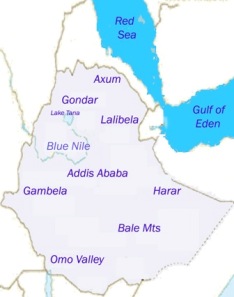
|
Timket & Omo Valley (Jan.18-28)
Join our Timket Tour which is
a very colorful & greatest celebration. All the tabots [Read More]
|
Travel Facts
Visa
& Immigration
All visitors, except from
Kenyan and Djiboutian nationals, are required an
entry visa to visit Ethiopia. The Ethiopian immigration
office issues visa upon arrival for the following
countries:-
Argentina, Austria, Australia, Belgium, Brazil, Canada,
China, Denmark, France, Germany, Finland, Greece, Ireland, Israel,
Italy, Japan, Korea, Luxemburg, Mexico, Netherlands,
Norway, Poland, Portugal, Russia, South Africa, Sweden,
Switzerland, Taiwan, UK, and USA.
Health
Requirements
Visitors
are required to have a valid health certificate
for yellow fever prior to entry. If a visitor
transited or visited cholera infected area within
six days prior to arrival in Ethiopia,a vaccination
against cholera is required
Currency
Exchange
Official
Currency: 1 birr=100 cents
Bank Hours:-Open from 0830 in the
morning to 1600 in the afternoon on weekdays
and half day on Saturdays. However, Banks at Addis
Ababa Hilton and Sheraton Hotels
are open daily including holidays from 0600-2300
hours. You can also cash visa & MasterCard
at the banks or use the ATM machine inside the hotels.
Travelers' cheque is best taken in US Dollars
or Pounds Sterling and cash is best taken in US
Dollars or Euro.
Some credit cards such as, Visa,
MasterCard, American Express and Dinners Club are
accepted at major hotels.
Time & Electricity
Ethiopia
is three hours ahead of GMT (+ 3 GMT)
Its electric supply is 220 volts,50 cycles AC.
| |
 |
Facts About Ethiopia
Ethiopia is found between 3 degree and 16 degree
north latitude,
and 33 degree and 48 degree east  longitude. It is bordering Sudan to the
west and North West, Eritrea to the north and
north east, Djibouti to the east, Somalia to the
east and south east and Kenya to the south.
It has an area of 1,235,000 square
kilometers. Out of which 65% is arable land
and about 15% is presently cultivated.
Topography
longitude. It is bordering Sudan to the
west and North West, Eritrea to the north and
north east, Djibouti to the east, Somalia to the
east and south east and Kenya to the south.
It has an area of 1,235,000 square
kilometers. Out of which 65% is arable land
and about 15% is presently cultivated.
Topography
Ethiopia has a variety
of distinct geographical zones ranging from one
of the lowest places in the world, the Danakil
depression, lies in the harsh salt flats at
116 meters below sea level, to a 4620 meter peak,
Ras Dashen, which is the highest in the
country, in the Simien Mountains. The most distinctive
feature is the vast central plateau with an average
elevation of between 1800m and 2400m with many
mountain peaks. The mountains of Ethiopia are
the sources of major rivers; the most famous is
the Blue Nile, which flows down from
the Garden of Eden in the paradise.
Generally, the topography of the country is incredibly
configured with majestic mountains, spectacular
gorges and rivers, some of which are chosen for
rafting such as, the Omo River.
Climate
Though Ethiopia is found with in the tropics,
its Climate reflects the topography that gives
her a diverse plantation, from desert bushes to
Afro-alpines, and wild life with many endemism.
The country receives heavy rainfall
from June to August. Almost every part of
the country receives precipitation during this time.
The dry season for most part of the country is
winter. April and May are the hottest months of
the year. Temperature varies accordingly to each
part of the country. Generally, the lowlands are
hot and warm but the highlands are cold with temperate
climate. There is, however, sunrise all year round
(Thirteen Months of Sun
Shine).
Economy
The country's economy is based in Agriculture.
About 85% of the population earns their living
from agriculture, mainly as subsistence farmers.
The country exports coffee, which brings about
47% of the country's foreign earnings. Oil seeds,
pulses, flowers, vegetables, and hides and skins
are other exports. Chat plant, mainly exported
to Djibouti and Somalia, is becoming the second
export earner. The country registered economical increase
during the last four years.
People
and Culture
There is no doubt that humans have inhabited
Ethiopia since the dawn of recorded history, as
indicated in early cave drawings. Ethiopia, the
second most populous nation in Africa next to
Nigeria, has a population of 75 million with high
dependency ratio. Over 50% of the population is
under 20years of age and 85% of the people is
still living in the country side. Life expectancy
is currently 49 years. Ethiopia has a diversified
culture of music, dance, art & literature, architecture, painting,
and poetry. Currently, there are about 83 ethnic
groups inhabiting the country, each with its own
language and sub culture. The main three languages
in the country are Amharic, which is the
official Language of the country, Oromigna
and Tigringa.
History
Ethiopia is generally considered Africa's oldest
continuously identifiable nation. In early ages,
Ethiopia bordered Egypt, encompassing parts of
what is now Sudan, and Yemen crossing the Red
Sea. Djibouti and parts of Somalia share much
of their ancient, medieval and modern histories
with the country. Ethiopia is the only African
country that has escaped colonialism. The country
became landlocked after the independence of Eritrea
in 1993. Above all, Ethiopia is known for its
exceptional historical attractions including centuries-old
rock hewn churches and castles, several famous
archaeological findings that give the country
the name "Cradle of Man kind". Having complex
traditions, ancient history and diversification,
Ethiopia is a fascinating destination for Trekkers,
culture lovers, nature lovers, bird watchers,
historians and others.
|
| | |
